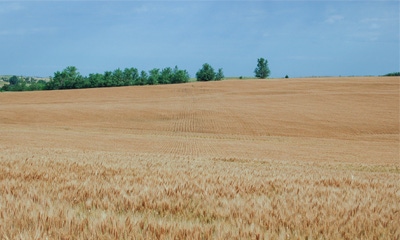July 13, 2016

Good seeding conditions in fall 2016 resulted in good winter wheat stands, which enabled the winter wheat crop to be more competitive with weeds. In some fields, uncontrolled stripe rust did open up the canopy, permitting weeds to germinate and get well-established. Also, due to the wet weather in May, some winter wheat fields had rather large broadleaf and grassy weeds.
Timely control of weeds following winter wheat harvest can limit soil moisture loss to weeds and prevent the deposit of more weed seeds in the soil, two factors that can benefit the next crop's yield. Also, timely control of volunteer wheat is essential in reducing the spread of wheat streak mosaic disease.

PROACTIVE MANAGEMENT: Timely control of weeds after winter wheat harvest is key to preventing soil moisture loss to weeds and the deposit of more weeds in the soil. Likewise, timely control of volunteer wheat helps reduce the spread of wheat streak mosaic disease.
In addition to hail causing early volunteer winter wheat, dormancy can also be reduced by higher temperatures during the later stages of the grain fill period. Normally, the grain fill period is 25 days or less, but it can exceed 35 days under good environmental conditions. Any temperature over 85 degrees F can reduce wheat yield potential. Therefore, if higher temperatures occurred during the later stages of grain fill, the dormancy period will be shortened and control of volunteer wheat may be needed sooner after harvest.
Timing is a factor in weed control
Weeds under stress are difficult to control. Kochia and Russian thistle are day-length-sensitive and will begin to flower in late July and into August. It's a general rule that you can wait up to 30 days after harvest to spray wheat grown as part of a three-year rotation. If the wheat was planted without an 11- to 14-month fallow period, spray it within 15 days of harvest. Examine each field separately, and adjust your treatment schedule accordingly. This year, some wheat fields will need to be sprayed before 15 to 30 days because of less competitive winter wheat stands and higher precipitation amounts. The key is to prevent weeds from using soil water and producing weed seeds.
As with all weed control, it's essential that you closely watch for weed developments and spray at the proper time to achieve maximum control. Most herbicide labels state that weeds must be treated before they are 6 inches tall. If weeds are under severe drought stress, wait for rain and spray about a week later.
Controlling weeds in the growing wheat offers the best chance of reducing weed population and vigor after harvest.
Split treatments an effective option
Split treatments, which have a good history of effectiveness, should be especially beneficial this year.
In Kansas, research has shown a 20-bushel increase in corn yields the next year for treatments applied in July compared to mid-August. When using a split treatment, apply the glyphosate products with companion herbicides (adding surfactant, if needed, plus ammonium sulfate) as the first application in July or early August. Some glyphosate products include sufficient surfactant, though many products require more. Be sure to check the product label.
For all glyphosate brands, add ammonium sulfate (spray grade) at 17 pounds per 100 gallons of spray solution. (The ammonium sulfate is the first item put into the spray tank after the water.) Ammonium sulfate is especially helpful when stress conditions are present. Liquid ammonium sulfate, with or without a drift retardant, also is available. It's difficult to recognize weed stress, so it's wise to always add ammonium sulfate.
Improve control by increasing the rate of glyphosate. Allow at least six hours — and longer with some weeds — for the glyphosate product to become rain-fast. Barnyardgrass may require 24 hours without rain for maximum control. With glyphosates, use a spray volume of 5 to 10 gallons per acre, and don't apply it when temperatures reach or exceed 95 degrees F.
Producers should control weeds in wheat stubble fields by applying the full label rate of glyphosate with 2,4-D or dicamba to the glyphosate unless susceptible crops or other sensitive vegetation are in the area. Other herbicides that may be added to glyphosate include Spartan, Charge, Authority MTZ, Valor and Sharpen. Tankmixes with glyphosate will help control weeds that are difficult to control with glyphosate alone and will help reduce the chances of developing glyphosate-tolerant weed populations. Always check labels and rotation restrictions.
If temperatures are above 80 degrees F, use the amine formulation of 2,4-D and dicamba.
The second part of the split treatment should be applied in September, and should contain at least ½ pound per acre of atrazine and possibly Gramoxone Inteon (add surfactant), depending on the amount and size of volunteer winter wheat, downy brome, jointed goatgrass or other weeds present.
For additional information, treatments, and rates go to the eco-farming section of the 2016 Guide for Weed Management, EC130, at marketplace.unl.edu/extension/extpubs/ec130.html.
Klein is a UNL Extension western Nebraska crops specialist.
Source: UNL CropWatch
You May Also Like




